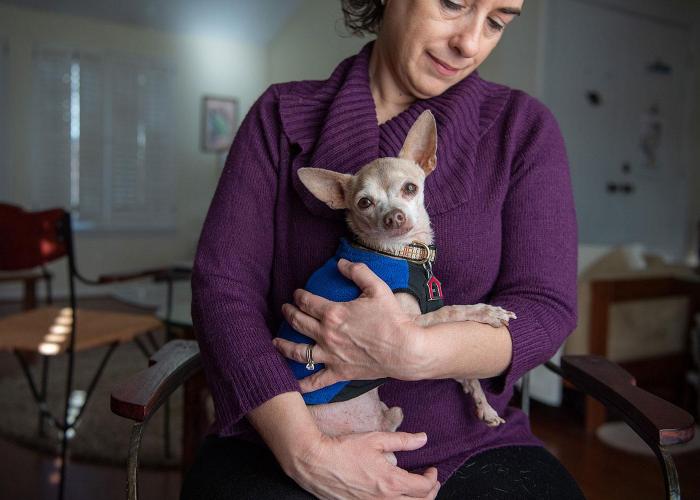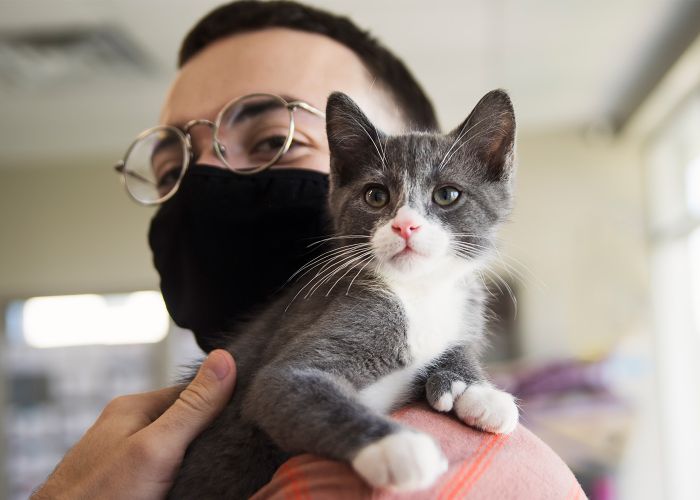Rethinking returns
Repurposing a shelter management tool to control the flow of animals who come back

It’s a scenario longtime rescuers have nightmares about, and yet we rarely see it coming: One day, seemingly out of the blue, you get the email message: “URGENT! I need to return Fido to you this weekend!”
“Oh, crud,” you think. Checking your records, you find that Fido was adopted a year and a half ago. The home that fostered him is currently full, as are all your other foster homes. You take a look around your own menagerie and sigh—you’re already drowning in kibble. It hits you that there’s never a good time for a return. It always throws your operations and your team into panic mode. You cry out to no one in particular, “There must be a better way to handle this!”
Happily, there is. Fed up with the chaos of admitting an unmanageable and unpredictable number of stray, surrendered, returned or injured animals every day, some shelters now use a process known as “managed admissions” to allow them to prepare for who’s coming through their doors and save spots for those animals who are most in need.
It’s likely that your rescue group already uses some form of managed admissions to make sure the number of animals you take from shelters or other sources doesn’t exceed your group’s capacity. But have you considered that managing your admissions also applies to your returns?
Controlling the Chaos
When you think about it, a managed returns system makes a lot of sense. We can’t resolve most other issues in our lives immediately. If your cable isn’t working, you call the cable company and make an appointment to wait (and wait and wait …) for a technician. If you’re not feeling well, you call the doctor’s office and request an appointment; you don’t go to the ER unless the issue is urgent. Just as these service providers have processes to control the flow of clients, we in the rescue world should feel empowered to implement a system that allows us more control over when animals return to our organizations.
Controlling the flow of when animals come into your organization can be the most powerful tool for improving their care and increasing positive outcomes, says Cindy Karsten, a veterinarian with the Koret Shelter Medicine Program at UC Davis in California. Rather than allowing people to surrender or return animals on demand, many organizations now require people to make an appointment or be placed on a waiting list for the next available space.

The Cleveland Animal Protective League in Ohio changed to a surrender-by-appointment policy in 2010. At the time, this wasn’t a strategic choice, says president and CEO Sharon Harvey, but a simple necessity. Faced with an outbreak of kennel cough, the shelter temporarily shut down intake for dogs to prevent anyone else from getting sick. Staff were honest and upfront with the public, letting people know that sick dogs were not going to be euthanized, and that they wanted to make the same promise to dogs coming in. Therefore, they explained, they needed people to make appointments and wait for cage space to ensure dogs a safe place and a good outcome.
The public’s reaction? “People got it. They understood,” Harvey says.
With that success under their belt, Harvey and her staff started questioning why it took the threat of a highly contagious disease to make a case for managing their capacity. They decided to keep the appointment system in place, and also encouraged people bringing in stray animals to hold on to them until space opened up. This strategy has boosted the shelter’s live-release rate and freed up its limited resources, allowing the League to take on complicated medical issues it couldn’t handle before.
Shifting Our Thinking
In the long run, a no-panic system for managing returns can also increase your rescue organization’s impact and community support.
It’s common for rescue groups to create adoption policies based on two commonly held (but often misguided) beliefs—that a return means we’ve failed, and that when it happens, we need to get the pet back into our care as quickly as possible. A fear of returns often underlies adoption policies that stress finding the “perfect” match, which in turn typically result in fewer adoptions. And when a pet is returned by that supposedly perfect adopter, we often feel blindsided.
We in the rescue world should feel empowered to implement a system that allows us more control over when animals return to our organizations.
By putting in place a proactive support system for adopters and managing returns, we can create an environment where the stakes aren’t nearly as high—because we don’t have to scramble to find a spot if an adoption doesn’t succeed. That calmer environment can actually improve our relationships with adopters. When we emphasize how carefully we try to match pets with adopters, it can be intimidating for adopters to admit that it’s not working out.
Just imagine that you’ve agreed to return your new pet to an organization that really didn’t think you were good enough in the first place, says Karsten. “I might have lied to them because I really wanted this pet and I had to lie to get it. And now if things don’t work out, I’ve lied to them, so I’m not as likely to go back. … I think that puts a lot of pressure on people to try to make it work, when maybe it’s not best for the pet or the family.”
In a perfect world, when we adopt out an animal, he stays in that home for the rest of his life. But life often gets in the way of our best-laid plans. We need a system that accounts for returns instead of creating more pressure to avoid them. In fact, a lower-pressure sales technique can actually lead to more adoptions. Karsten likens it to shopping at Zappos, the shoe-shopping website. “I love Zappos,” she explains. “Their customer service is absolutely spectacular. … It’s free shipping to you and [free] returns, so it’s no-pressure shopping. Do I shop more? Absolutely! Do I return more? Not usually. It may be the intent, but once it’s in my home [it tends to stay there]. And so it takes a lot of the pressure off.”
Of course, adopting a pet is not the same as purchasing shoes, and our goal isn’t to offer the easy, instant returns retailers pride themselves on. But when we accept, as the retail industry does, that there will always be some returns, we can prepare for that. And in the process, we can improve our relationships with adopters, lessen our own stress, spend our resources on the animals who are most in need and dramatically increase the number of lives we’re saving.
Confronting Our Fears
Effective managed admissions policies go hand-in-hand with strong pet retention programs, says veterinarian Graham Brayshaw, director of animal services at the Animal Humane Society (AHS) in Golden Valley, Minn. Since switching to an appointment-based surrender system in 2009 and requiring people to call a hotline, AHS has been able to prevent about a third of callers looking to surrender a pet from doing so.

Pet retention programs can provide adopters with post-adoption support, temporary boarding assistance, resources for behavior, medical or housing issues or other proactive services to help keep pets in their homes. It’s a matter of “finding ways to not admit animals if we really don’t need to,” Harvey says.
The most important element for developing pet retention resources, Karsten says, is choosing staff “who are compassionate but firm … who really want to be problem solvers.”
Brayshaw notes that when AHS switched to a managed admissions process, many staff members were nervous about the potential backlash. But they’ve found that most owners understand, while “the occasional person yells at you no matter what you do, and it goes along with the job. But the worst that happens in those cases is that they either leave the animal and go, or they take off and are mad at you and try to badmouth you. But those are by far the exceptions.”
The worst reactions AHS has encountered involved emotional blackmail—“the threat of ‘Oh, I’m just going to go shoot him’ or ‘I’m going to dump him on the road, I’m going to do this or do that,’” Brayshaw says.
We can improve our relationships with adopters, lessen our own stress, spend our resources on the animals who are most in need and dramatically increase the number of lives we’re saving.
The worst reactions AHS has encountered involved emotional blackmail—“the threat of ‘Oh, I’m just going to go shoot him’ or ‘I’m going to dump him on the road, I’m going to do this or do that,’” Brayshaw says.
Remaining calm and complimenting the owner in the face of those rare reactions can de-escalate the situation; it’s helpful to respond with something along the lines of, “Simply the fact that you called us or you came here means you care about this animal,” Brayshaw notes. Explaining how taking in the animal may affect the others in the organization’s care can help the owner understand the policy.
Harvey empowers her staff to make exceptions to the surrender-by-appointment rule when they feel there’s an animal or person who needs immediate assistance. That helps quell fears that the system may have negative consequences.
But what about people who schedule appointments to surrender their pet and then don’t show up? In following up, Harvey has found that “a good percentage of the time, people have decided to keep the pet, or they found another home themselves.” What the Cleveland shelter has learned, she says, is that making surrenders easy has “actually been enabling people to look at their animals as easily disposable, rather than having them really have to think about it.”
Brayshaw’s team also follows up with owners who don’t keep their surrender appointment, and checks with their local animal control to make sure the animals didn’t get surrendered elsewhere. They’ve found that while animal control’s intake has slightly increased, because managed admissions policies have enabled AHS to better control its capacity, the organization has been able to take in more animals from animal control. So any increase in animal control’s intake is offset by AHS’s higher capacity.
Putting Managed Returns Into Practice
When making policy changes and providing new resources, it’s important to use all available outlets to notify people. Have a prominent page on your website letting people know about the change, alert readers of your newsletter, have signs at adoption events—use whatever resources you have to tell your former and future adopters that you can help them resolve pet-related issues. If your managed returns policy is relatively new, consider giving people a grace period and allowing returns-by-demand if someone insists.
It’s also critical to set expectations early on. Karsten recommends telling people during the adoption process. Let adopters know that they can return a pet, but that they need to contact you the first time they have an inkling that something is wrong so that you can try to solve the problem or start looking for another home.
And remember that there are two sides to the coin. Scheduling returns works best when you have strong pet retention programs in place. As most rescue groups don’t have a central facility, think creatively about how you can implement an effective program to keep pets in their homes. For example, your organization may want to hold regularly scheduled and well-publicized “office hours” where adopters can speak with a representative about any issues they’re having. You may want to start following up with adopters on a regular basis. Remember that at the end of the day, Karsten says, “the adoption process should be the beginning of your relationship [with adopters], not the end.”







